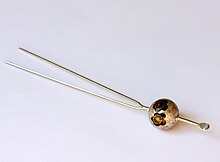Kanzashi
During the Nara period, a variety of Chinese cultural aspects and items were brought to Japan through mutual trade and envoys.
Artisans began to produce more finely crafted products, including some hair ornaments that could be used as defensive weapons.
[citation needed] During the latter part of the Edo period, the craftsmanship of kanzashi is considered to have reached a high point, with a number of styles and designs created, many of which persist to the modern day.
Some hobbyists have bypassed the traditional apprenticeship system to establish themselves as independent artisans of tsumami kanzashi in Japan.
[6] Kanzashi are fabricated from a wide range of materials, such as lacquered wood, gold and silver plated metal, tortoiseshell, silk, and recently, plastic.
A number of other styles of kanzashi also exist, though these are typically only worn for specific, uncommon hairstyles, such as by maiko in certain geisha districts or by characters in some kabuki plays.
The flowers are glued to backings of metal or cardboard that are attached to a wire and are bunched together to make bouquets and other arrangements.
Additional detailing of stamens is created by the use of mizuhiki, a strong, thin twine made from washi paper, often coloured and used for decorative works.
















